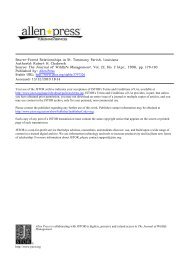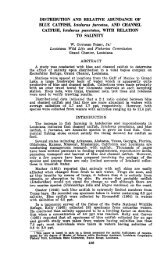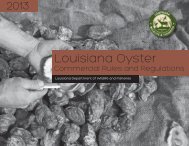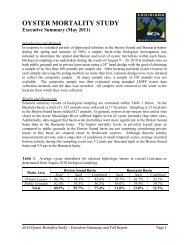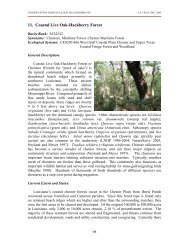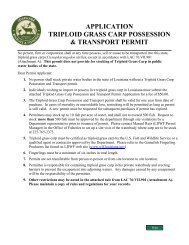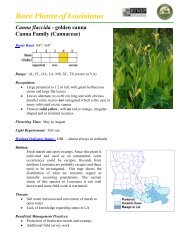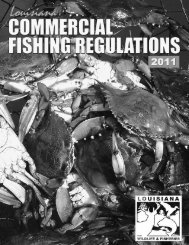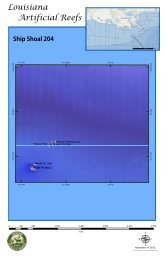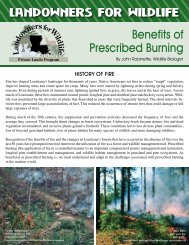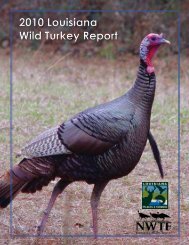Wildlife Insider Spring Summer 2010 - Louisiana Department of ...
Wildlife Insider Spring Summer 2010 - Louisiana Department of ...
Wildlife Insider Spring Summer 2010 - Louisiana Department of ...
You also want an ePaper? Increase the reach of your titles
YUMPU automatically turns print PDFs into web optimized ePapers that Google loves.
will be used to guide our forest managementdecisions.To accomplish this objective, LDWFoperates bird banding stations during birdbreeding seasons. The banding stationsare located at Sherburne and Pearl RiverWMAs, which <strong>of</strong>fer superb habitat formany nongame bird species. Fourteen species<strong>of</strong> nongame birds listed in the WAP asspecies <strong>of</strong> conservation concern regularlyutilize both WMAs (e.g., yellow-billedcuckoo, wood thrush, prothonotary warbler,Swainson’s warbler, painted bunting)(Figure 1).In <strong>2010</strong>, LDWF is completing the seventhyear <strong>of</strong> the MAPS study. A minimum<strong>of</strong> 10 years <strong>of</strong> MAPS banding is desirableto determine avian population response.In addition to assessing local populationtrends, we participate in the nationwideMAPS program, which also allows researchersto assess regional breeding landbirdpopulation trends.“Locality Data for Bats in Northeastern<strong>Louisiana</strong>”(SWG No. T-10-3 – Completed in 2009)Rafinesque’s big-eared bat and the southeasternmyotis are two species <strong>of</strong> concern,both in <strong>Louisiana</strong> and the southeasternUnited States. From July 2008 throughJune 2009, 15 sites within <strong>Louisiana</strong> wererepeatedly searched for bats and signs <strong>of</strong>their presence. During these surveys, 63new roost sites were discovered in Union,Ouachita and Caldwell parishes. Althoughone roost was discovered in an abandonedwell, roost sites were typically found inwater tupelo and bald cypress tree cavities.The information gathered about these roostsites helps the LDWF further understandthe population status, distribution and habitatrequirements <strong>of</strong> these species in <strong>Louisiana</strong>.This study was part <strong>of</strong> an ongoing,long-term project conducted by the <strong>Louisiana</strong>Natural Heritage Program to inventorymany rare species throughout the state.“A Survey <strong>of</strong> Fishes Inhabiting the Pearl,Tchefuncte and Tangipahoa River Systemsin <strong>Louisiana</strong>”(SWG No. T-49 – Completed in 2009)Of the 41 species <strong>of</strong> fishes listed as species<strong>of</strong> conservation concern in the WAP, 14occurred historically in river systems locatedin the Southeastern Plains and SouthernCoastal Plain ecoregions <strong>of</strong> southeastern<strong>Louisiana</strong> (including all or parts <strong>of</strong> Livingston,St. Helena, St. Tammany, Tangipahoaand Washington parishes). In order todocument the current distribution and status<strong>of</strong> these species, the Tangipahoa, Tchefuncte,Pearl, Bogue Chitto, Pushepetapaand Bogue Lusa rivers were sampled usingseines and electro-fishing gear in 2007 and2008. A total <strong>of</strong> 74 species were capturedand identified. Four <strong>of</strong> the species collectedare listed as species <strong>of</strong> conservation concern:gulf sturgeon in the Bogue Chitto;<strong>Spring</strong>/<strong>Summer</strong> <strong>2010</strong>blue sucker in the Pearl River; frecklebellymadtom in Pushepetapa Creek; and flagfinshiner in Bogue Lusa Creek and tributaries<strong>of</strong> the Bogue Chitto River (Figure 2).“Herpet<strong>of</strong>aunal Surveys on <strong>Wildlife</strong> ManagementAreas”(SWG Nos. T-03, T-05, T-06, T-17, T-24,T-26 – Completed between 2005-2008,SWG Nos. T-78, T-85 – Current)Six SWG projects have included herpet<strong>of</strong>aunal(i.e., reptiles and amphibian species)surveys <strong>of</strong> bottomland hardwood ecosystemson WMAs. A total <strong>of</strong> 20 WMAswere surveyed from 2003 to 2006. Most<strong>of</strong> these projects gathered baseline surveyinformation essential to the development<strong>of</strong> the WAP. The common objectives<strong>of</strong> these projects were to estimate relativeabundance, species composition and habitatutilization <strong>of</strong> amphibians and reptiles onWMAs. The projects also resulted in newspecies occurrence records for several parishes.The studies utilized several surveyand sampling methods, including visual encounters,Anuran call surveys, drift fences,pitfall traps, funnel traps, cover board surveysand aquatic trapping (Figure 3).In <strong>2010</strong>, we have begun two new studiesfocusing on herpet<strong>of</strong>aunal diversitythrough much <strong>of</strong> <strong>Louisiana</strong>. Researchersplan to sample aquatic herpet<strong>of</strong>auna invarious wetland types on Boeuf WMA toevaluate species diversity as it relates tohabitat type and quality. In another study,LDWF will sample a range <strong>of</strong> reptiles andamphibians from various sites throughoutcentral and eastern <strong>Louisiana</strong>, developinglong-term monitoring stations to help usevaluate any changes in diversity and richnessas relatively unaltered landscapes areexposed to development or fragmentation.ConclusionSince its start, the State <strong>Wildlife</strong> GrantProgram has funded more than 80 projectsin <strong>Louisiana</strong>. The initial years <strong>of</strong> theprogram have provided much informationconcerning species about which we previouslyknew very little. That knowledge laidthe foundation for the <strong>Wildlife</strong> Action Plan.With the plan in place, an outline now existsthat will guide research and managementdecisions with the ultimate purpose<strong>of</strong> preventing wildlife and fisheries speciesfrom becoming endangered.LDWF’s mission is to manage, conserveand promote wise utilization <strong>of</strong> <strong>Louisiana</strong>’srenewable fish and wildlife resources andtheir supporting habitats for the social andeconomic benefit <strong>of</strong> current and futuregenerations. State <strong>Wildlife</strong> Grants and the<strong>Wildlife</strong> Action Plan have become an increasinglyimportant part <strong>of</strong> that missionduring this first 10 years <strong>of</strong> research andconservation, and LDWF only anticipatesgreater achievements through SWG as thisprogram continues in the years to come.Photo courtesy <strong>of</strong> Grant TherkildsenPhoto courtesy <strong>of</strong> Ryan DanielPhoto courtesy <strong>of</strong> Ben ThatcherFigure 1. A white-eyed vireo waits to beremoved from a MAPS mist net. Mist netsare made <strong>of</strong> fine thread which makes thenets essentially invisible to flying birds,ensnaring those that attempt to fly throughthe nets.Figure 2. LDWF Inland Fisheries Divisionhoop net sampling.Figure 3. The Gulf Coast mud salamander,uncommon throughout its range, is listedas a species <strong>of</strong> conservation concern in theWAP. A new herpet<strong>of</strong>auna survey (T-85)will include known areas <strong>of</strong> occurrence t<strong>of</strong>urther document its population status in<strong>Louisiana</strong>.For More InformationFor further information, pleasecontact LeAnne Bonner at 225-765-0239 or visit LDWF’s websiteat the following address:http://www.wlf.louisiana.gov/experience/wildlifeactionplan/.11



